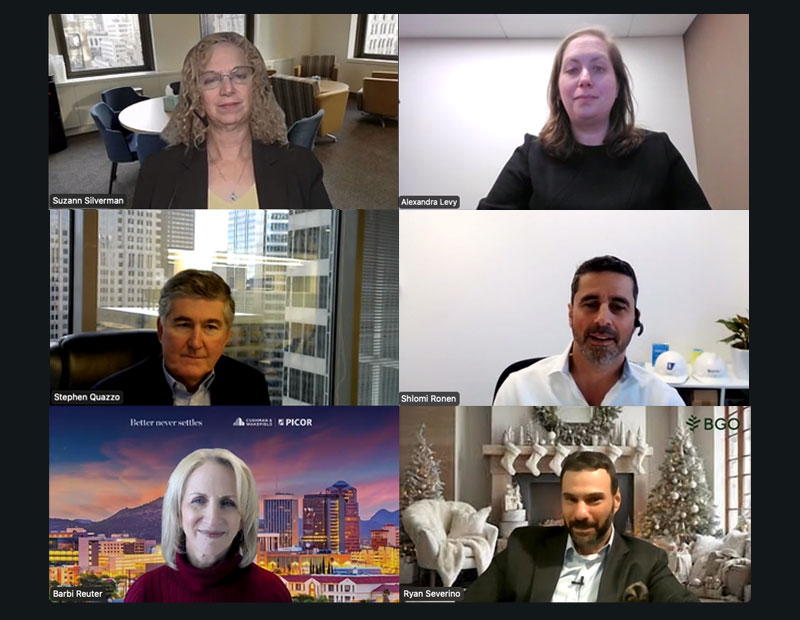2025 CRE Outlook: The Year Ahead


The whirlwind of 2024 is coming to a close. Commercial real estate went through rate increases, cuts, an election, economic uncertainty and volatility in the capital markets. And that’s just scratching this year’s surface. Yet, overall market fundamentals are looking up.
As 2025 approaches, Commercial Property Executive brought together some of the nation’s top CRE experts. In CPE’s 2025 Outlook: Navigating the New Year webinar, moderated by Editorial Director Suzann Silverman, executives shared expectations about valuations and transactions, as well as deals that highlighted the current market.
To set the stage, Ryan Severino, chief economist at BGO, addressed the “800-pound gorilla in the room:” interest rates. After the long series of hikes that have been recently followed by two cuts, Severino observed that inflation has slowed considerably and that the worst is likely in the rearview mirror.
READ ALSO: Why Aren’t Mortgage Rates Dropping After Fed Rate Cuts?
All things considered, “The economy has been nothing short of spectacular,” Severino stated. There is also a general confidence that, over the next 12 to 24 months, the Federal Reserve will pull the figure closer to a “neutral rate.” The hoped effect would be pulling investors off of the sidelines and boosting deal volume.
Finding investors
Transaction activity should start to tick up industry-wide in 2025, it was widely agreed. But it’s essential to get lenders and capital investors back in the game so deals pencil. Shlomi Ronen, managing principal & founder at Dekel Capital, said that more opportunistic and value-add capital is likely to pop up.
“If you’ve got the opportunistic capital right now, and can be somewhat of a contrarian, investing in ground-up multifamily development—which is a space we’re leaning into right now—is a great place to be,” Ronen added. Taking a longer-term view and buying office assets could offer similar opportunities.
READ ALSO: Life Cos. Drive More Lending, Banks Take Back Seat
Pension funds have had a tough couple of real estate years, yet opportunity is on the way, predicted Stephen Quazzo, co-founder & CEO of Pearlmark Real Estate.
“There are some rays of sunshine as we look out into 2025,” he said. “You have this denominator effect: The stock market continues to boom; the real estate allocation is a lower percentage. So I think they certainly have room in their allocations.”
For assets looking to recapitalize, equity from long-term investors such as pension funds will continue to be a good source. Foreign lenders may be another. Alexandra Levy, Americas head of debt capital markets at LaSalle Investment Management, said that while it’s difficult to generalize sentiment due to differing regulations, there are signs from overseas.
“We are continuing to see international lender interest at the fund-level financing,” Levy said. “There’s been a shift from property level to fund level. It’s a way to continue to support real estate, either through subscription lines or repo facilities for back leverage, while not having the direct exposure.”
International banks are also still lending into national markets on a property-level basis, Levy noted.
Impacts of the election on CRE
The other 800-pound gorilla in the room: the presidential election. But does it really impact CRE? Barbi Reuter, CEO & principal, Cushman & Wakefield, doesn’t think so. Election cycles and property performance don’t have much of a correlation, according to her company’s data mapping. While the impact on fundamentals is likely minor, she noted that solid GDP growth could positively impact leasing.
“In our area, we’ll be looking if potential changes in immigration policy could affect labor shortages,” Reuter said. “Certainly, border states and others are impacted.”
READ ALSO: Will CRE Market Conditions Improve?
Local economic policy changes could also impact markets. For example, municipalities and states have to respond and deliver—individually—on things such as clean energy, zoning initiatives and power infrastructure, which could impact CRE on local levels, Reuter noted.
Quazzo agreed that, from an investment standpoint, some markets are more or less attractive due to their local policies. Specifically, property tax rates and transfer taxes are factors to consider.
A positive 2025 CRE outlook
Considering the strong economy going into 2025, Severino said that CRE is starting to see a shift. He noted that, despite sentiment being a more-or-less “soft indicator” in the market, there is a positive anticipation of where rates are headed. This slide away from a more negative outlook is, in itself, removing a major headwind.
“You’re starting to see people thinking a little more aggressively down the road and about deploying more capital once we’re in a different interest rate environment, six, 12 to 18 months from where we are now,” Severino said.
LISTEN TO: CRE Sentiment at Best Level in 2 Years
Over that same timeline, Ronen anticipates a lot of pressure on debt funds and distressed assets. The highly discussed wave of approaching maturities is going to continue to apply this pressure and ultimately lead to more transactions.
“Once we see that transaction volume pick up, we are going to get a market clearing price and cap rates for multifamily, and all the other asset classes, that will then help spur other investment,” Ronen reasoned. That’s the big question right now: Where are cap rates on these assets?
A recent Cushman & Wakefield report showed that about 50 percent of the distress pipeline is in office, Reuter noted. While this is potentially unsurprising, there is a silver lining.
“The rate of growth was slowest for distress that it’s been in two years,” Reuter mentioned. “That’s a positive indicator.”
When it comes to distress, Levy said, it is important to consider the one caused by higher rates and the refinancing gap.
“Whether we believe the forward curve or not, as rates begin to pull in, that refinance gap lessens,” Levy continued. As more deals come to market, it will be interesting to see which are distressed and which are related to smoother market dynamics.
The post 2025 CRE Outlook: The Year Ahead appeared first on Commercial Property Executive.




